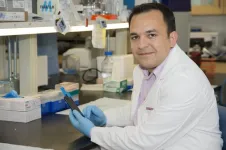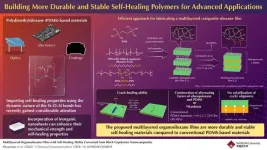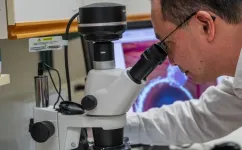(Press-News.org) Linoleic acid, an omega-6 fatty acid found in seed oils such as soybean and safflower oil, and animal products including pork and eggs, specifically enhances the growth of the hard-to-treat “triple negative” breast cancer subtype, according to a preclinical study led by Weill Cornell Medicine investigators. The discovery could lead to new dietary and pharmaceutical strategies against breast and other cancers.
In the study, published March 14 in Science, the researchers found that linoleic acid can activate a major growth pathway in tumor cells by binding to a protein called FABP5. Comparing breast cancer subtypes, the team observed that this growth pathway activation occurs in triple-negative tumor cells, where FABP5 is particularly abundant, but not in other hormone-sensitive subtypes. In a mouse model of triple-negative breast cancer, a diet high in linoleic acid enhanced tumor growth.
“This discovery helps clarify the relationship between dietary fats and cancer, and sheds light on how to define which patients might benefit the most from specific nutritional recommendations in a personalized manner,” said study senior author Dr. John Blenis, the Anna-Maria and Stephen Kellen Professor of Cancer Research in the Department of Pharmacology and a member of the Sandra and Edward Meyer Cancer Center at Weill Cornell Medicine.
Omega-6 linoleic acid is a diet-derived nutrient that is considered essential in mammals for supporting multiple bodily processes. However, the abundance of this fat in ‘Western-style’ diets has increased significantly since the 1950s, coinciding with the increased usage of seed oils in fried and ultra-processed foods. This has led to concerns that excessive omega-6 intake might be one of the explanations for rising rates of certain diseases, including breast cancers. But decades of studies have yielded mixed and inconclusive results, and have never uncovered any biological mechanism tying omega-6s to cancers.
In the new study, the researchers sought to resolve this confusion by initially looking at breast cancer, which has been linked to modifiable factors such as obesity. They looked at the ability of omega-6 fatty acids—particularly linoleic acid, the dominant one in the Western diet—to drive an important, nutrient-sensing growth pathway called the mTORC1 pathway.
A key initial finding was that linoleic acid does indeed activate mTORC1 in cell and animal models of breast cancers, but only in triple-negative subtypes. (The term “triple negative” refers to the absence of three receptors, including estrogen receptors, that are often expressed by breast tumor cells and can be targeted with specific treatments.) The scientists discovered that this subtype-specific effect occurs because the polyunsaturated fatty acid forms a complex with FABP5, which is produced at high levels in triple-negative breast tumors but not in other subtypes, leading to the assembly and activation of mTORC1, a major regulator of cell metabolism and cancer cell growth.
Feeding mice that model triple-negative breast cancer a high-linoleic-acid diet increased FABP5 levels, mTORC1 activation and tumor growth. The researchers also found increased levels of FABP5 and linoleic acid in the tumors and blood samples from newly diagnosed triple-negative patients.
The findings show that linoleic acid can have a role in breast cancer, though in a more targeted and defined context than previously appreciated. The study also is thought to be the first to establish a specific mechanism through which this common dietary ingredient influences disease.
The illumination of FABP5’s importance in this process suggests, moreover, that it could be a good “biomarker” to guide more personalized nutritional and therapeutic interventions for patients with triple negative breast cancer, which currently lacks any targeted therapy.
The researchers have only begun to investigate the effects of omega-6-FABP5-mTORC1 signaling in other diseases, but in the study, they showed that the same pathway can enhance the growth of some prostate cancer subtypes.
“There may be a broader role for FABP5-mTORC1 signaling in other cancer types and even in common chronic diseases such as obesity and diabetes,” said study first author Dr. Nikos Koundouros, a postdoctoral research associate in the Blenis laboratory.
END
Omega-6 fatty acid promotes the growth of an aggressive type of breast cancer
2025-04-01
ELSE PRESS RELEASES FROM THIS DATE:
FAU secures $1.3 million NIH grant for breakthrough in HIV self-test technology
2025-04-01
As of the end of 2023, nearly 40 million people worldwide were living with HIV, including approximately 1.2 million in the United States. In the same year, about 630,000 people globally died from AIDS-related illnesses. Although this is a significant decline from previous years, AIDS-related deaths remain a critical global health challenge.
While antiretroviral therapy (ART) has improved the life expectancy of people with AIDS, a lack of effective diagnostics and disease management tools has hindered its global implementation. Only 59% of those in need have access to treatment, and about one in four people living with HIV are unaware of their status. Additionally, ...
Study finds higher cardiac deaths in combined day-night heatwaves
2025-04-01
Cardiac deaths increase significantly during compound heatwaves—heatwaves where temperatures are elevated both during the day and overnight—according to a new study in JACC, the flagship journal of the American College of Cardiology. The study also found that some types of heart disease are more sensitive to heatwaves than others and that different types of heatwaves may impact heart health in distinct, nonlinear ways.
The research highlights the special risks of compound heatwaves ...
NYC, Baltimore research scientists receive grants to study cardiovascular/diabetes connection
2025-04-01
DALLAS, April 1, 2025 — A New York City-based physician scientist who explores ways to improve health by looking at the ways in which cells and molecules impact disease and an epidemiologist from Baltimore who has devoted her career to identifying ways to improve screening, diagnosis and patient care for people with diabetes are the most recent American Heart Association Merit Award recipients. Over the next five years, each researcher will receive a total of $1 million in funding from the Association, a global force changing the future of health for all.
The American Heart Association’s Merit Award is one of ...
AI propaganda: prolific and persuasive
2025-04-01
A study of the use of AI by a Russian-backed propaganda outlet shows how AI allows propagandists to increase their production capacity without any loss in persuasive power. In December 2023, journalists at the BBC and Clemson University’s Media Forensics Hub published an investigation revealing that the site DCWeekly.org was a Russian propaganda outlet, part of a broader network disseminating pro-Kremlin and anti-Ukrainian narratives. Morgan Wack and colleagues found that prior to September 20, 2023, much of the content on the site was simply lifted from other right-leaning outlets. After that date, however, the stories were generally rewritten by AI, allowing the site to use a broader ...
An efficient self-assembly process for advanced self-healing materials
2025-04-01
Polysiloxane materials, such as polydimethylsiloxane (PDMS)-based elastomers, exhibit a self-healing capability by the introduction of silanolate (Si–O–) groups. This ability stems from their dynamic siloxane (Si–O–Si) bonds, which can break and reform to repair damage. Their self-healing properties could make them valuable in applications like protective coatings for use in various fields, such as optics, electronics, and aerospace.
To improve the properties of PDMS-based materials, they have been combined with inorganic fillers such as nanoparticles or nanosheets. Generally, the introduction of nanosheets into polymers leads to the formation of ...
Study reveals stark racial disparities in IBD care across the united states
2025-04-01
New York, NY – April 1, 2025- A study published today in the American Journal of Gastroenterology reveals significant disparities in healthcare utilization among racial and ethnic groups with inflammatory bowel disease (IBD) in the United States. The research, funded by the Centers for Disease Control and Prevention (CDC), led by investigators from the University of Pennsylvania, the University of North Carolina at Chapel Hill, and the Crohn's & Colitis Foundation provides crucial insights into the challenges faced by underrepresented communities ...
Break the sedentary cycle: National Walking Day can kickstart healthier routines
2025-04-01
DALLAS, April 1, 2025 — Sedentary behavior has become a national health crisis, with 1 in 4 U.S. adults sitting for more than eight hours a day, increasing their risk for heart disease, stroke, and mental health challenges, according to the Centers for Disease Control and Prevention. To help people move more, the American Heart Association, a global force changing the future of health of all, invites communities nationwide to walk together on Wednesday, April 2.
Adopting healthier routines doesn’t have to be intimidating or overwhelming according to Eduardo Sanchez MD, MPH, FAHA, the ...
Researchers develop new way to match young cancer patients with the right drugs
2025-04-01
A pan-Canadian team has developed a new way to quickly find personalized treatments for young cancer patients, by growing their tumours in chicken eggs and analyzing their proteins.
The team, led by researchers from the University of British Columbia and BC Children’s Hospital Research Institute, is the first in Canada to combine these two techniques to identify and test a drug for a young patient's tumour in time for their treatment.
Their success in finding a new drug for the patient, described today in EMBO Molecular Medicine, shows how the study of proteins, known as proteomics, ...
New 3D technology paves way for next-generation eye-tracking
2025-04-01
Eye tracking plays a critical role in the latest virtual and augmented reality headsets and is an important technology in the entertainment industry, scientific research, medical and behavioral sciences, automotive driving assistance and industrial engineering. Tracking the movements of the human eye with high accuracy, however, is a daunting challenge.
Researchers at the University of Arizona Wyant College of Optical Sciences have now demonstrated an innovative approach that could revolutionize eye-tracking ...
Diagnosing a dud may lead to a better battery
2025-04-01
It’s (going to be) electric.
But how soon? How quickly our society can maximize the benefit of electrification hinges on finding cheaper, higher performance batteries — a reality closer to hand through new research from Virginia Tech.
A team of chemists led by Feng Lin and Louis Madsen found a way to see into battery interfaces, which are tight, tricky spots buried deep inside the cell. The research findings were published on April 1 in the journal Nature Nanotechnology.
“There are major, longstanding challenges at the interfaces,” ...



